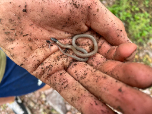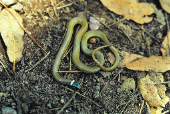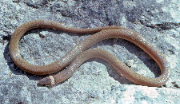Chihuahuan Black-Headed Snake (Tantilla wilcoxi)
Description: The Chihuahuan Black-headed Snake is a slender and small. 356 mm total length, tail length is 24 to 26% of total length, light tan, brown, or yellowish-brown snake dorsally with a dark gray-brown cap on the top of the head that extends to or below the corner of the mouth. A distinct off-white or pale cream collar, two scale rows wide, is always present immediately posterior to the dark head cap. The anterior portion of the light collar crosses the tips of the parietal scales. That collar is bordered posteriorly and often anteriorly by a thin gray-brown band or dotted lines that are typically darker than the head cap and 0.5 to 1.5 scale rows wide. The supralabials are mostly white, and that color expands posterior to the eye so that all of the fifth and usually part of the sixth supralabials are white, forming a light cheek patch. Minute dark spots or maculations are present on the dorsal scales. The venter lacks spots, and is cream or white anteriorly, grading to light pink or orange posteriorly. All Tantilla lack loreal scales.
Habitat: Of the four species of Tantilla found in Arizona, the Chihuahuan Black-headed Snake is the most specialized in terms of habitat use. Throughout its range, it is primarily a species of montane canyons and slopes in oak or pine-oak woodland.
Range: The species' range extends from the Huachuca, Santa Rita, and Patagonia mountains of extreme southeastern Arizona in the United States, south to eastern Sinaloa, Durango, San Luis Potosi, and Nuevo Leon, Mexico. Its elevational range extends from 3,000 to 8,000 feet.
Found in these States:
AZ
Diet: Prey items include many species of suitably sized invertebrates, especially arthropods.
Reproduction: females lay clutches of 1 to 3 eggs.
Status: The Chihuahuan Black-headed Snake is listed as a species of least concern on the IUCN's Red List. However, its montane woodland habitats are at risk in Arizona from wildfire and climate change. Major stand-replacing fires in the Huachuca and Santa Rita mountains over the last 40 years have degraded the habitat of this species, while in some areas of Mexico forested habitats of the Chihuahuan Black-headed Snake have been heavily logged. Mining can eliminate habitat of this species locally.
»» Kingdom: Animalia - Animals
»» Phylum: Chordata - Chordates
»» Subphylum: Vertebrata - Vertebrates
»» Class: Reptilia - Reptiles
»» Order: Squamata - Scaled Reptiles
»» Suborder: Serpentes
»» Superfamily: Colubroidea
»» Family: Colubridae - Colubrids
»» Genus: Tantilla
»» Species: Tantilla wilcoxi - Chihuahuan Black-Headed Snake
This article uses material from a Tucson Herpetological Society article "Chihuahuan Black-Headed Snake", which is released under the Creative Commons Attribution-Share-Alike License 3.0. Content may have been omitted from the original, but no content has been changed or extended.
|












